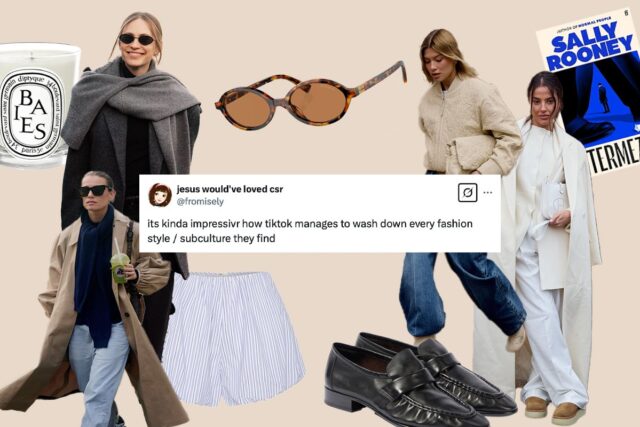Everyone dresses like they live in Copenhagen now; clean and minimalist. I’ve never been there before, but I’ve been told it’s so me.
The line was delivered like a compliment, an algorithmic pat on the back if you will. But as I later scrolled on TikTok I see a girl wearing cream trousers and The Row’s scrunched black loafers, paired with the small round Miu Miu glasses. I nodded. I liked it. I saved it. But something felt off. Like, I’d already seen it too many times for it to feel like a choice.
Taste used to feel like instinct, or a subversion. We weren’t trying to be understood. The whole aesthetic of mystery has been turned into moodboards with names and TikTok core labels; Scandi-aesthetic, castlecore, coquettecore. Each one offering the illusion of agency while quietly telling you what to wear, what to read, what to want. Trends that chew up and spit out references before they can even mean anything.
Instagram knows I want brown leather loafers before I do.
My explore page feels like an eerie mirror, reflecting versions of myself I haven’t decided to be yet.
This isn’t about mourning some imagined past, it’s about the slow, aching dislocation that comes from living in a world where every reference is a reference to something else. Where cool is no longer a feeling, but a formula: 3 per cent personal tweak, 97 per cent Pinterest.
As Virgil Abloh once put it, the 3 per cent rule suggests that making even a minimal change to an existing idea is enough to make something feel new, while still carrying the weight of nostalgia. And yet, nostalgia fatigue feels more present than ever. The return of Y2K and indie sleaze makes me wonder if everything is coming back and being labelled as retro, then is anything truly retro? In The Slow Cancellation of the Future, writer Mark Fisher focused on music, but the same theory applies here; we’re gravitating toward past styles for comfort and out of exhaustion, and innovation feels like it’s stalled.
When was the last time something felt like a discovery. Not a recommendation. Not a trend forecast. Just mine. Maybe that’s the new rebellion to want quietly, to like sincerely, to resist the need to be something. But even that, is already a trend. And this extends further into subculture. If everything becomes so readily available, it becomes harder and harder to resonate – music, films, books and even politics.
When opening the explore page on TikTok, everything is perfectly curated to be shaped into my desires and what I like, before I even know what I want. The term coined for this trend is ‘algorithmic homogenisation’ – where an algorithm, powered by artificial intelligence is designed to learn about you and optimise the content you receive. It can be helpful. It acts as a bit of a double-edged sword, or rather a paradox.
The algorithm has the potential to enrich our lives with diversity and unique perspectives and offerings. But on TikTok, this can look like endless iterations of references that create the same ‘it-girl’ aesthetic, the same beauty ideals.
And while fashion used to predominately trickle down from runways to the streets, we’re seeing the influence of what goes viral online, in the next season shows. Hyper-sexualised prep (better known as Office Siren), Y2K low-rise, coquette – bows and ballet core were a big one for the runway last year.
Relatability is now a commodity. And authenticity is curated carefully. How we connect and find what we like online is judged on how much we can relate. This is the performance of taste in 2025. An aesthetic of effortlessness underwritten by effort. The same frilly shorts, the same Diptyque candle, and the book splayed open to a Sally Rooney quote. And looking at this content of what seems to be intimate reflections of self, are really just screenshots of a larger mood board. One we all seem to be filling in together. Influencers and content creators that used to be relatable, now feel out of reach. We dress for resonance not revolt. I think about this often, this slow erosion of private subjectivity. The way cool has flattened into a grid of references, on a constant rotation. To dress like someone who doesn’t care – except they clearly do.
I want to wear something not because it’s good, but because it’s wrong. I want my taste to embarrass me again.
I want to want without explanation. Taste and trust seem to be lost and confused; because when everyone is a micro curator how do you know what you actually like?
Maybe that’s the thing – I don’t know how to be cool anymore because cool doesn’t exist now. It’s pre-loaded, pre-approved, peer-reviewed. It arrives in packages, in palettes, in perfectly filtered frames. And when everything is cool, nothing really is. I used to think cool was something you felt. Now it feels like something you download. Something you try on and hope it fits. But I’m tired of trying things on. I want to wear what makes no sense. I want to get it wrong. To be uncool so sincerely it becomes its own kind of freedom.
2025-03-31 07:45:00
#cool #exist #era #curated #authenticity
Source link
















